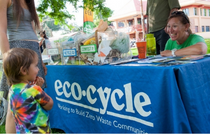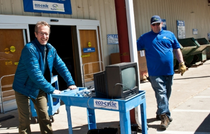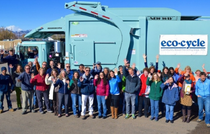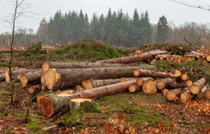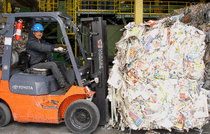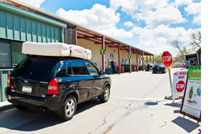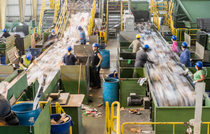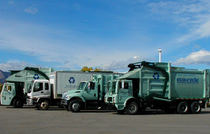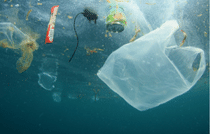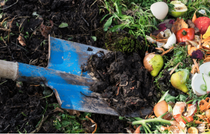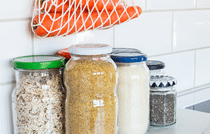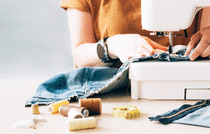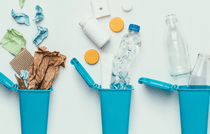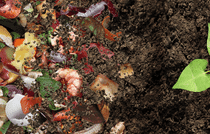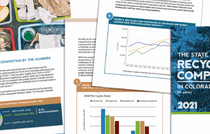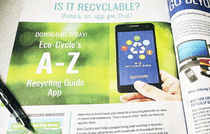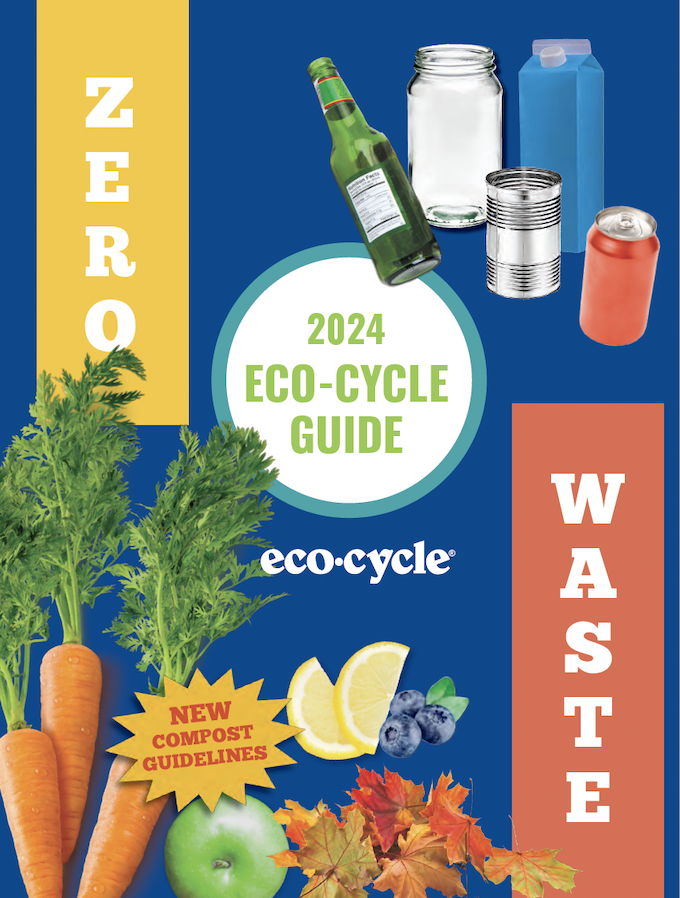What are household hazardous wastes?
Many products found in your kitchen, bathroom, garage, or garden shed are potentially hazardous substances. Because of their chemical nature they can poison, corrode, explode, or burst into flame when handled improperly. When discarded, they are household hazardous wastes.
Motor oil, paints, pesticides, antifreeze, wood preservatives, batteries, and conventional household cleaners are all examples of everyday hazardous items that should be handled with care. They can contain solvents, petroleum products, heavy metals, or other toxic chemicals that can injure people or contaminate underground drinking water sources if dumped in the trash, on the ground, or poured down the drain.
How do I know if a product is hazardous?
Hazardous products are described by at least one of the following properties:
Toxic
Substances that, even in small quantities, may immediately poison, or cause injury or death through repeated exposure, when inhaled into the lungs, chewed, swallowed, or absorbed through the skin. Examples include rat poison, pesticides, and bleach.
Flammable/Inflammable
Liquids, fumes, and sometimes solids that will easily ignite and burn. Examples include lighter fluid and paint removers.
Corrosive
Substances or vapors that can burn skin on contact and can eat away the surface of other materials. Examples include oven and toilet bowl cleaners.
Reactive
Substances that react with air, water, or other substances to produce toxic or explosive vapors. Examples include bleach when mixed with ammonia-based cleaners.
To protect yourself, read the label. Look for the following words: “POISON,” “TOXIC,” “CORROSIVE,” “VOLATILE,” “FLAMMABLE,” “INFLAMMABLE” (which means the same thing as “flammable”), “COMBUSTIBLE,” “EXPLOSIVE,” “DANGER,” “CAUTION,” “WARNING,” and “HARMFUL.” These words alert you to the nature of the product.
How to Reduce and Avoid Hazardous Waste
- Think before you buy, and choose safer alternatives whenever possible. For example, choose water-based products over solvent-based ones.
- Avoid aerosols whenever possible, and avoid products containing chlorinated compounds, petroleum distillates, phenols, and formaldehyde.
- Avoid chemical air fresheners.
- Try to buy only what you need so you aren’t left with hazardous waste.
- Give leftover products to a responsible neighbor or friend who can use them.
- Add pest- and disease-resistant species of companion plants to your garden to avoid the need for potentially hazardous chemical fertilizers, weed killers, and insecticides.
- Reassess your tolerance of pests and, if you must kill them, learn how to target them more accurately.
Don’t use banned or restricted chemicals!
Never use banned or restricted pesticides, including DDT, Aldrin, Chlordane, Compound 1080, Dieldrin, dibromochloropropane (DBCP), Dinoseb, Endrin, ethylene dibromide, Heptachlor, Kepone, Lindane, Mirex, pentachlorophenol, Silvex, strychnine, toxaphene, or 2,4,5-T.
General Guidelines for Proper Handling of Household Hazardous Wastes
DO NOT dispose of hazardous waste in the trash, down the drain, onto the ground, or on the street.
All of these methods may result in health and/or environmental problems.
DO NOT store corrosives, flammables, and poisons together.
Separate these containers.
DO NOT repackage chemical products in containers that are normally used for food products or soft drinks.
Food and soft drink containers are not designed to safely store hazardous liquids, and children have died from accidentally drinking chemicals stored in soft drink bottles.
Learn more about what’s under your sink or in your garage from the Consumer Protection Information Database (CPID), which lists thousands of household products with full descriptions about how to use them and how to dispose of them safely.
Ten Tips for Using Household Chemicals
- Before you buy a product, read the label carefully. Make sure you know what you are purchasing.
- Choose products with child-resistant packaging.
- Buy only the amount you need. Reduce or eliminate the disposal problem.
- Select the least toxic products available. Choose nontoxic alternatives when you can.
- Use multipurpose products whenever available.
- Store all toxic products away from children and pets in safe, airtight containers.
- Follow label directions. Use only what is needed. Twice as much does not mean twice the results.
- Never mix different products. Explosive or poisonous chemical reactions may occur.
- Always store leftovers in the original container with the original label.
- Never eat, drink, or smoke when handling hazardous materials.
Household Hazardous Waste Facts
Learn more about Household Hazardous Waste, including what to do if you are at risk of harm, at poison.org.
- Most people think of “hazardous wastes” as wastes generated by industry, but many household products contain the same chemicals found in industrial hazardous wastes. Improper disposal of household hazardous wastes, such as throwing them away with your household trash, dumping them in storm drains, or into sewer or septic systems, can endanger your health, the health of others, and that of the environment.
- Products as seemingly innocuous as synthetic detergents for dishwashing and laundry are some of the most frequent causes of poisonings.
- Bleach is considered a household hazardous waste and should be used with caution and kept out of reach of children. Open windows and ventilate well if using bleach—exposure can irritate the throat, lungs, eyes, and skin. Baking soda and water is a safer cleaner than diluted bleach. Use borax or soda to whiten. Borax is also a good grease cutter.
- Ammonia cuts heavy grease and grime but can be dangerous. Fumes irritate eyes and lungs and can be harmful to people with respiratory problems. Always provide good ventilation. Never mix ammonia with bleach or commercial cleansers—deadly fumes may form. Use ammonia only when other cleansers won’t do the trick. Need a good ammonia-free window cleaner to replace your Windex? Try our recipe of 1 part vinegar, 6 parts water for a streak-free clean.
- Household hazardous wastes should be kept out of landfills; some can be recycled or even reused (such as perfectly usable but unwanted paint). Less hazardous waste in the landfill means less hazardous leachate, which requires expensive treatment. The risk of soil and groundwater pollution from leachate seepage is also reduced. Garbage collectors and landfill workers can be injured by exploding aerosol cans, splashing chemicals, or poisonous fumes created by mixed chemicals. Chemical reactions can also cause fires in garbage collection trucks or within landfills.
- Household hazardous wastes should never be flushed into septic systems or down sewer drains because these wastes can kill the active bacteria in your septic tank or at the wastewater treatment facility. These bacteria perform safe and essential biological processes used to break down waste. Wastewater treatment facilities cannot remove all heavy metals and these may contaminate sewage sludge, water supplies, and animal habitats.
- Household hazardous wastes should never be poured onto the ground or down storm drains. Products such as motor oil contain toxic chemicals and metals (e.g., hydrocarbons, lead, zinc, arsenic, chromium, and cadmium) that will contaminate groundwater, drinking water, and freshwater wildlife habitats. Other products may also have an adverse effect on water supplies and the environment.
Need to drop off household hazardous waste?
Many municipalities have their own household hazardous waste services for residents. Check your city or town’s website for a hazardous waste facility or drop-off near you.
- Live in Boulder or Broomfield County? Click here to learn more about Household Hazardous Waste in the Boulder County area.
- Not sure if your item is a hazardous material? Check out our A–Z Recycling Guide for Boulder County.
